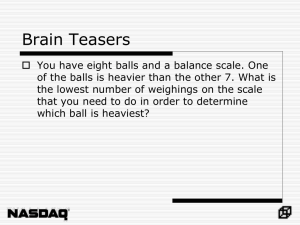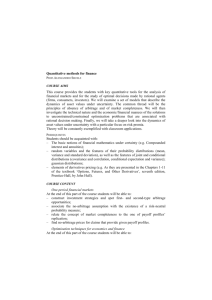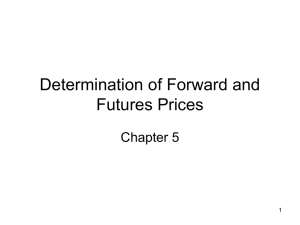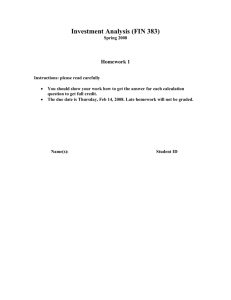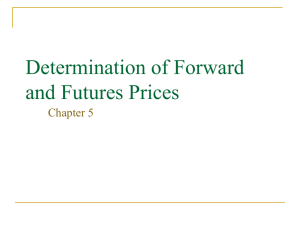Lecture 3: Forward Contracts Steven Skiena Department of
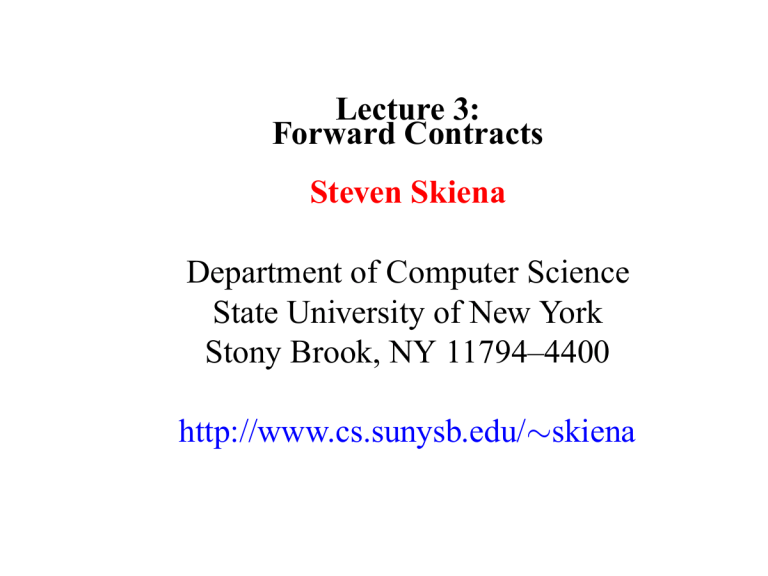
Lecture 3:
Forward Contracts
Steven Skiena
Department of Computer Science
State University of New York
Stony Brook, NY 11794–4400 http://www.cs.sunysb.edu/
∼ skiena
Derivatives
Derivatives are financial instruments whose value derives from the values of other, more basic variables.
Options give the owner the right, but not the obligation, to buy or sell a security at a specified price on (or perhaps before) a specified date.
The Chicago Board of Exchange (www.cboe.com) trades options on over 1200 stocks and stock indices.
Futures contracts gives one the right and obligation to buy or sell a commodity at a given price at a given time.
Forward Contracts
Forward contracts give the owner the right and obligation, to buy or sell a given security at a specified price on a specified date.
The long position on the contract agrees to buy the security on the date. They are betting the the price will go up.
The short position on the contract agrees to sell the security on the date. They are betting the the price will go down.
Forward contracts can be worth less than zero. If I have the long position on an expiring forward contract for $100 and the price is $90, this will cost me $10.
Enforcing Contracts
That futures/forward contracts can go negative implies that mechanisms must be in place to ensure ultimate delivery.
Both the legal system and the Mafia have effective enforcement mechanisms, but they only work if the party can pay.
Futures markets have developed mechanisms to ensure payment, typically settling gain/loss on a daily basis for cash.
Margin Requirements and Leverage
A particularly important mechanism to enforce financial contracts are margin requirements, where the owner must put cash/securities in escrow to prove they can cover the losses.
Should prices fall, additional collateral is needed to cover the potential losses.
Margin requirements are particularly important when borrowing money to buy securities. Such leveraged trading strategies increase returns at increased risk.
The Dangers of Leverage
Suppose I buy $1000 of securities with only $100 down (a leverage factor of 10). A price decline of only 10% wipes out all my capital!
Difficulties in satisfying margin calls trigger forced selling, which can compound into sudden price declines.
Much of the current troubles in the financial markets result from too much leverage applied to risky securities.
Uses of Forward Contracts
Forward contracts are used in foreign exchange to hedge the risks of currency fluctuations.
If I have to pay $1 million to someone in 1 year, and I have the equivalent in Euros, I can either (a) take a risk the prices will not change, (b) convert it all now and sit on it, (c) keep the money and buy a forward contract for the equivalent amount of Dollars in 1 year.
Forward contracts are signed between two parties, not traded on exchanges.
Relating Spot and Forward Prices
What is the correct forward price for a security/asset whose current (spot) price is S
T
?
If the forward price is too high, I can borrow money to buy the asset, and take a short position to guarantee myself a profit.
Example : Suppose the spot price for Microsoft is $100 a share, the interest rate is 5% per year, and the forward price is $115 for a one year contract.
Buying the share will cost me $5 for borrowing the money, so this strategy will guarantee me $15 - $5 = $10 profit a year from now with no risk.
This simple analysis ignores transaction costs, and the timevalue of money.
Pricing Forward Contracts
If the forward price is too low, and I either own or can borrow the asset, I can take a long position to guarantee myself a profit.
Example : Suppose the spot price for Microsoft is $100 a share, the interest rate is 5% per year, and the forward price is $100 for a one year contract.
I can sell my share now, earn interest on the money for a year, and through my forward contract buy back the share a year from now, so this strategy will guarantee me $105 - $100 =
$5 profit at no risk.
At any price except $105, the forward contract gives somebody an arbitrage opportunity.
What About Future Prospects?
If we assume that all parties are intelligent and can borrow money at the same interest rate, the forward price is completely determined by this theory.
Why doesn’t the expectation of future price changes factor in?
If everybody “knows” the price is going to jump tommorow, it would have already jumped today!
The current spot price would already reflect this future movement.
Arbitrage Assumptions
In our analysis of arbitrage strategies, we will make the following assumptions:
•
There are no transaction costs for trading.
•
There are no tax and/or accounting and/or storage cost considerations on trading.
•
All participants can borrow and lend money at the same risk-free rate of interest.
•
Arbitrage opportunities are taken advantage of as they occur.
These assumptions greatly simplify the analysis, but do not completely reflect the messy truths of the market.
Pricing Forward Contracts
By arbitrage arguments, the T year forward price F
0 asset S
0 which provides no income is
F
0
= S
0 e rT for an where r is the risk-free interest rate.
If the forward price is higher than this, borrow money and buy the asset now, short the forward contract, and deliver the asset then.
T years from now I have F
0 −
S
0 e rT
> 0 at no cost!
If the forward price is less than this, short the asset, put the money in the bank, go long on the forward contract, and deliver it then.
T years from now I have S
0 e rT
−
F
0
> 0 at no cost!
Contracts on Interest-Paying Assets
Many stocks/bonds pay interest/dividends to their owners at regular intervals.
Forward pricing changes when the assets pay interest at an annual rate of q :
F
0
= S
0 e
( r
− q ) T because the party who owns the asset gets to keep the interest.
If the forward price is higher than this, borrow money, buy the asset now, short the forward contract, keep the interest, and deliver the asset then.
If the forward price is less than this, short the asset, put the money in the bank, go long on the forward contract, pay the owner the interest, and deliver the asset then.
Stock Index Futures
The value of stock index futures (e.g. S&P 500) can be so computed given the expected dividend rate q paid by stocks in the index, otherwise there exists an arbitrage opportunity in buying/selling the component stocks.
The transaction costs here are substantial, but would be worthwhile if the index future prices get too out of whack.
Contracts with Fixed Payments
If cash with present value I is returned to the asset holder during the time period, the value of the forward contract is
F
0
= ( S
0 −
I ) e rT
Storage costs and combinations of fixed-value payments
(coupons) can be priced in this manner.

